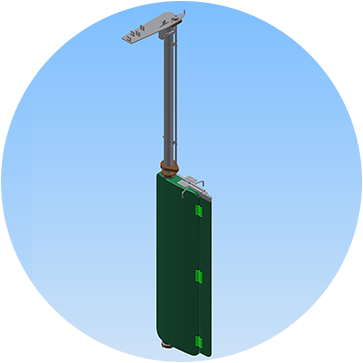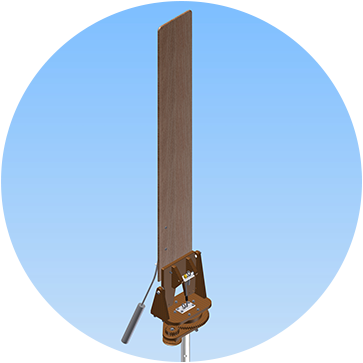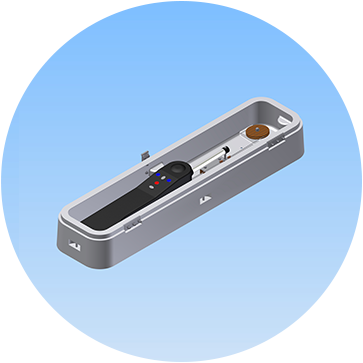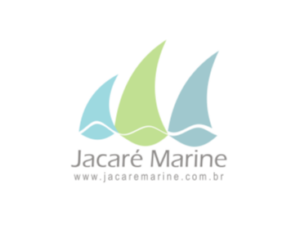Jacaré Windhelm
Background Introduction
For the last forty years I have had contact with many cruising yachts. I have designed, built and fitted numerous wind vane steering systems, all of which functioned, but I have never exploited my designs commercially.
Some years ago a friend arrived in a 28 ft monohull ketch and he badly needed wind vane steering. As the mizzen boom extended aft of the transom, it was virtually impossible to fit any available system.
This prompted me to design and build a wind vane with a remote wind sensor and an auxiliary rudder. Back in the eighties, I built a device to enable an Autohelm 800 to control an Atoms self steering fitted to a 42 ft catamaran. That worked well and used an outboard motor control cable to transmit the movement to the wind vane. Combining these ideas with my experience of previously built systems I have now produced the Jacaré Windhelm self steering system.
I believe that this is the only significant development of self steering in the last twenty or thirty years. Today there are only about a dozen wind vane options for the cruising yacht. I have managed to overcome most of the inherent disadvantages of all of them.
- Extreme vulnerability when moored or anchored.
- The wind sensor is mounted directly above the transom where any obstructions interfere with its operation.
- All available systems use components that can only be replaced by parts from the original manufacturer.
- Many rely on the boat’s rudder and steering system which is continually in use and suffering wear. Hydraulic steering cannot be used with most wind vane systems.
Some thoughts about cruising yachts and their equipment:
- Some things must never break. Mast, keel and rudder.
- If it breaks and you cannot mend it yourself you must be able to do without it, at least until the next port.
- Steering by hand on an ocean crossing should not be required except in very exceptional conditions.
- The sea and electricity are not good partners.
- Power at sea should come from the wind, the sun and your muscles, only
Let’s look at item number three, self steering. There are several options and much has already been written by well qualified people.
- Self Steering for Sailing Craft John S. Letcher
- Wind Vane Self Steering Handbook Bill Morris
- Self Steering Under Sail Peter Forthmann
- Sailing With A Windvane Alvah Simon
Jacaré Windhelm and its Advantages:
The Wind Vane and Rudder or Paddle Power units offer a complete non-electrical self-steering system that is easy to install and, as the units are connected only by a control cable, the wind vane can be mounted in any convenient location away from the Rudder or Paddle Power. (Above the solar panels, for example.)
- The tiller pilot adaptor and rudder units provide electronic course control using the smallest and cheapest autopilot with minimum drain on the boat’s batteries.
- All components are designed for minimum maintenance and ease of repair if damaged. There are no components that have to be replaced by the manufacturer. All can be manufactured by a local workshop. (If necessary, we can send you engineering drawings of the damaged part or a replacement part.)
- Suitable for multihulls and monohulls, sail or displacement motor.
- The boat’s steering system is resting when the Windhelm system is operative. (Except with the Paddle Power unit.)
- The Jacaré Windhelm rudder unit is a complete back-up steering system.
- The rudder unit and Paddle Power units can be quickly and easily removed and stored on the boat when not in use. Keep them safe and clean!
Below is a video going through the many advantages to the Jacaré Windhelm system.
Jacaré Windhelm Units

Rudder Unit
This is an auxiliary rudder that will steer the boat while the boat’s rudder and steering system are inactive. When not in use the auxiliary rudder is completely free to rotate through 360 degrees so will not interfere with the steering of the boat, even when going astern. When moored or anchored, the rudder unit can be removed in a matter of seconds, leaving only two mounting brackets on the stern of the boat.
Wind Vane Unit
This device senses changes in the relative wind angle and moves a control cable which actuates the Rudder Unit or Paddle Power Unit to maintain a constant heading in relation to the apparent wind.


The Tiller Pilot Adaptor Unit
The tiller pilot (Autohelm ST 1000, Navico TP100 or similar) is housed in a fiberglass box which can be located in any convenient position from which a push pull control cable can be routed to the Rudder Unit or Paddle Power Unit. As the tiller pilot never has to exert any significant force its consumption of electricity is very small and, furthermore, it is protected from the weather at all times, so very unlikely to fail. In conditions when the wind vane cannot be used, motoring for example, the Tiller Pilot Adaptor Unit, in conjunction with the Rudder Unit or Paddle Power Unit will steer the boat on a compass heading. When the boat is unattended the tiller pilot can be un-plugged, lifted out of the box and stored in a secure place. Some multihulls cannot use a wind vane due to the significant changes of relative wind angle as they accelerate with changes in the wind speed. The Tiller Pilot Adaptor Unit can be used on these boats, greatly reducing the demand for electricity when compared with conventional electric autopilots.
Paddle Power unit
This unit receives the signal from either the Wind Vane Unit or Tiller Pilot Adaptor Unit to control a servo pendulum which, via control ropes, moves the tiller to steer the boat with its own rudder. This is not a back-up steering system although, in an emergency, the paddle can be locked in its central position and used as a small substitute rudder.

Jacaré Windhelm Prices for standard units.
- Rudder Unit: Standard specification. Rudder 1000mm, support tube 2000mm. Rudder and trim tab in GRP, trim tab operating mechanism and top unit with engage and disengage cable. R$10.260,00
- Wind vane unit: Wind vane unit, two fiberglass vanes, 300mm support tube (1 ½” OD). One control cable. R$7.950,00
- Paddle Power Unit: Pendulum and support with one wooden paddle of 1,000 mm. Engage/disengage cable. 4 Pulleys and ropes with a tiller attachment bracket and stainless steel chain. R$9.100,00
- Tiller Pilot Adaptor Unit: GRP housing 800mm x 220mm x 150mm complete with internal mechanisms, Cable leaving from left of box when viewed from the operating side. One control cable. Tiller pilot not included. Suggest Autohelm ST1000. R$6.850,00
- Transom mounting bracket: Design and specification will depend on the style of the boat’s transom. A standard mounting bracket and attachment fittings are included in the price of the Rudder Unit or Paddle Power unit. Exceptional cases will be quoted separately.
Final price will depend on our suggested dimensions for the rudder unit and the mounting arrangements. We need to know all about the shape and dimensions of your boat. Drawings or sketches and photographs will enable us to give a firm quotation.
All prices are FOB Cabedelo, Paraiba, Brazil.
Delivery will normally be 60 days.
Payment by transfer to our bank account. 50% on confirmation of our proposal and the rest on delivery to the transporter.
